
Christian Corsten
Alumnus
Room 2205
This email address is being protected from spambots. You need JavaScript enabled to view it.
+49 241 80-21073
Christian completed his PhD on force touch on handheld touchscreens at the Media Computing Group under the supervision of Prof. Dr. Jan Borchers in 2020. To find out what he did next, check out our alumni page.
| Research | Publications |
PhD Thesis "Use the Force: How Force Touch Improves Input on Handheld Touchscreens" — Abstract
Handheld devices, such as smartphones, have become essential tools in our everyday life. We use them, e.g., to contact people, browse the web, or take pictures. For whatever use, to interact with the handheld device, we hold it with one or two hands and touch with our fingers on the built-in touchscreen. However, this interaction is often constrained to simple contact between the finger and the flat display glass, although touch offers further, richer properties. One such rich property is the intensity of a touch, i.e., its force, that the user applies with every tap to the touchscreen. Incorporating this property into the user’s interaction with the handheld device enables her to become more expressive with every single touch. In this thesis, we present a series of interaction techniques that take advantage of force touch input to make handheld interaction more efficient:
When holding the device with two hands in landscape orientation, most of the fingers are unavailable for interaction, since they rest at the back of the device (BoD), holding it in place. Using BoD force input, we can make efficient use of these fingers without sacrificing stability of the device grip. Our technique, BackXPress, enables quick access to shortcuts and menus to augment users’ touch interaction with the frontal screen.
For single-handed device use, users can only use their thumb to interact with the frontal touchscreen but cannot reach everywhere without re-grasping the device. Our virtual thumb extension, ForceRay, lets the user cast a ray at unreachable targets and control a cursor on that ray that moves closer to these targets the more force is applied. The technique is ergonomic for the thumb and enables users to maintain a steady device grip. Targets located at the screen edges, like menus and navigation buttons, are acquired quickly.
Selection of values from long ordered lists, such as picking a date or time, can also be sped up when using force input. With our Force Picker, users scroll through the value range at various speeds, with the speed being coupled to the force exerted by the thumb. Prior rolling of the thumb to the left or right sets the scrolling direction. Compared to touch-based pickers, our Force Picker not only makes selection faster, but also only consumes little screen space since the gesture footprint for force input is much smaller.
While controlling force via fingers requires practice, we show that with training and algorithmic optimizations, users become quickly familiar with force input and gain the benefits of the added expressiveness for handheld interaction.
I successfully defended my PhD thesis on March 10, 2020. The full text of the thesis will be available on our publications page by June 2020.
Research Projects
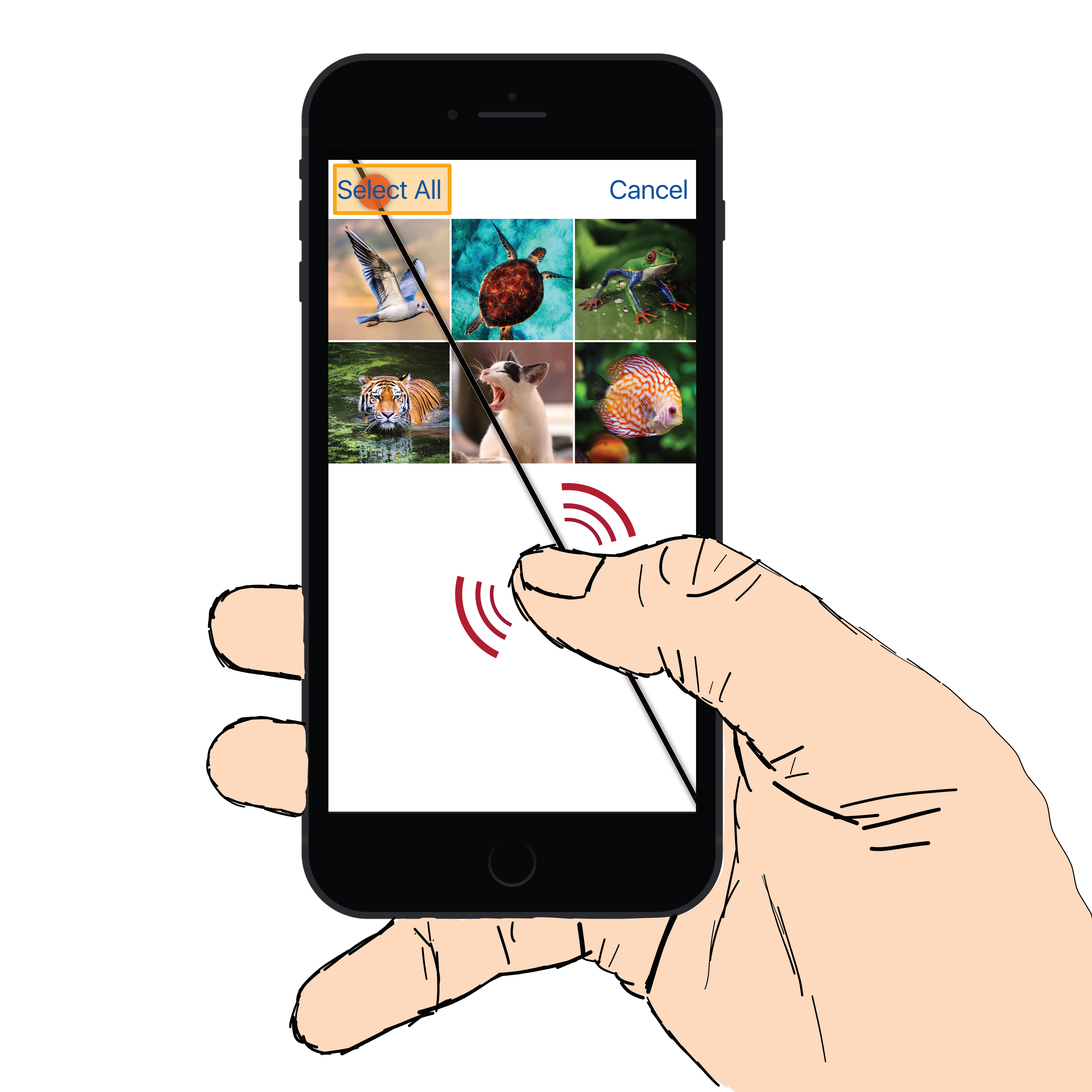
ForceRay: Extending Thumb Reach via Force Input Stabilizes Device Grip for Mobile Touch Input
ForceRay is a solution to reachability issues for one-handed smartphone interaction using force input. This interaction technique enables users to select targets at edges and corners quickly while maintaining a stable device grip. (read more)
Paper at CHI 2019
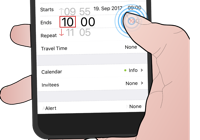
Use the Force Picker, Luke: Space-Efficient Value Input on Force-Sensitive Mobile Touchscreens
Value pickers on smartphone occupy significant gesture and display space. Instead, Force Picker allows for bidirectional force control to select values and requires no more space than the initial touch. (read more)
Paper at CHI 2018. Received Honorable Mention Award.
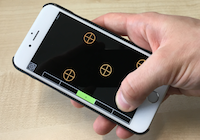
Release, Don't Wait! Reliable Force Input Confirmation with Quick Release
Modern smartphones, like iPhone 7, feature touchscreens with co-located force sensing. This makes touch input more expressive, e.g., by enabling single-finger continuous zooming when coupling zoom levels to force intensity. Often, however, the user wants to select and confirm a particular force value, say, to lock a certain zoom level. The most common confirmation techniques are Dwell Time (DT) and Quick Release (QR). While DT has shown to be reliable, it slows the interaction, as the user must typically wait for 1 s before her selection is confirmed. Conversely, QR is fast but reported to be less reliable, although no reference reports how to actually detect and implement it. In this paper, we set out to challenge the low reliability of QR. (read more)
Note at ISS 2017

BackXPress: Using Back-of-Device Finger Pressure to Augment Touchscreen Input on Smartphones
BackXPress lets users create pressure input with six fingers at the back of landscape-held smartphones to augment their frontal touchscreen interaction. We present design guidelines derived from three studies. (read more)
Full Paper at CHI 2017
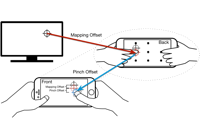
Understanding Back-to-Front Pinching for Eyes-Free Mobile Touch Input
Investigates the influence of device thickness and tilt angle for back-to-front pinching on mobile touch devices. Pinch error significantly increases with thickness while the angle has no influence.
Paper at MobileHCI 2016
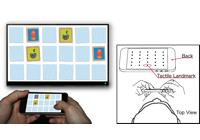
HaptiCase: Back-of-Device Tactile Landmarks for Eyes-Free Absolute Indirect Touch
An interaction technique for eyes-free absolute indirect touch based on back-of-device tactile landmarks and proprioception. Improves tapping accuracy significantly (14% target size reduction) without software modification. (read more)
Full Paper at CHI 2015

Instant User Interfaces enable users to repurpose everyday objects as input devices in an ad-hoc manner. We implemented a reliable, marker-free object tracking system that enables users to assign semantic meaning to different poses or to touches in different areas. (read more)
Full paper at ITS '13, St Andrews, UK.
Instant User Interfaces is part of our DFG-funded AURA project.

Fillables are low-cost and ubiquitous everyday vessels that are appropriated as tangible controllers whose haptics are tuned ad-hoc by filling, e.g., with water. (read more)
Extended Abstracts for alt.chi at CHI 2013, Paris.
Fillables is part of our DFG-funded AURA project.
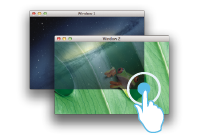
Forceposé uses a pressure-sensitive touchpad to enable quick glances and interactions with occluded windows in Mac OS X. (read more)
Demo at UIST 2012 Student Innovation Contest, Boston.
Supervised Bachelor's or Master's Theses
- Marcel Lahaye (Master's Thesis, co-supervised with Dr. Simon Voelker)
- Marten Junga (Bachelor's Thesis)
- Benedikt Langenberg (Master's Thesis, Psychology)
- Andreas Link (Master's Thesis)
- Björn Dählmann (Bachelor's Thesis)
- Sarah Suleri (Master's Thesis)
- José Mínguez Garrigues (Bachelor's Thesis)
- Ravi Kanth Kosuru (Master's Thesis)
- Christian Humme (Bachelor's Thesis)
- Christian Cherek (Master's Thesis)
- Tatiana Smirnova (Master's Thesis)
- Anke Brocker (Bachelor's Thesis)
- Marcel Lahaye (Bachelor's Thesis, co-supervised with Nur Al-Huda Hamdan)
- Daniel Kaulen (Master's Thesis, external at UCSD, San Diego)
- Sebastian Hueber (Bachelor's Thesis)
- Andreas Link (Bachelor's Thesis)
- Tarek Hassan (Master's Thesis)
My Own Theses
Co-Optjects (Master's Thesis, 2012)
DragonFly (Bachelor's Thesis, 2009)
Internships
I interned at the Human-Computer Interaction Laboratory, UCSD, codirected by Jim Hollan. I've been working on two digital pen and paper projects, called PLink:mac and fluid PLink.


Publications
- Simon Voelker, Sebastian Hueber, Christian Corsten and Christian Remy. HeadReach: Using Head Tracking to Increase Reachability on Mobile Touch Devices. In Proceedings of the 2020 CHI Conference on Human Factors in Computing Systems, CHI '20, pages 739:1–739:12, ACM, New York, NY, USA, April 2020.




- Christian Corsten. Use the Force: How Force Touch Improves Input on Handheld Touchscreens. PhD Thesis, RWTH Aachen University, Aachen, March 2020.


- Christian Corsten, Marcel Lahaye, Jan Borchers and Simon Voelker. ForceRay: Extending Thumb Reach via Force Input Stabilizes Device Grip for Mobile Touch Input. In Proceedings of the 2019 CHI Conference on Human Factors in Computing Systems, CHI '19, pages 212:1–212:10, ACM, New York, NY, USA, May 2019.




- Christian Corsten, Simon Voelker, Andreas Link and Jan Borchers. Use the Force Picker, Luke: Space-Efficient Value Input on Force-Sensitive Mobile Touchscreens. In Proceedings of the 2018 CHI Conference on Human Factors in Computing Systems, CHI '18, pages 661:1–661:12, ACM, New York, NY, USA, April 2018.




- Christian Corsten, Bjoern Daehlmann, Simon Voelker and Jan Borchers. BackXPress: Using Back-of-Device Finger Pressure to Augment Touchscreen Input on Smartphones. In Proceedings of the 2017 CHI Conference on Human Factors in Computing Systems, CHI '17, pages 4654–4666, ACM, New York, NY, USA, May 2017.




- Christian Corsten, Simon Voelker and Jan Borchers. Release, Don’t Wait! Reliable Force Input Confirmation with Quick Release. In Proceedings of the 2017 ISS Conference on Interactive Surfaces and Spaces, ISS '17, pages 246–251, ACM, New York, NY, USA, Oct 2017.




- Nur Al-huda Hamdan, Ravi Kanth Kosuru, Christian Corsten and Jan Borchers. Run&Tap: Investigation of On-Body Tapping for Runners. In ISS '17: Proceedings of the 2017 ISS Conference on Interactive Surfaces and Spaces, ACM, New York, NY, USA, Oct 2017.



- Nur Al-huda Hamdan, Marcel Lahaye, Christian Corsten and Jan Borchers. Presentation Strategies for Micro-Navigation in the Physical World. In Extended Abstracts of the 2016 CHI Conference on Human Factors in Computing Systems, CHI EA '16, pages 3062–3068,May 2016.



- Christian Corsten, Andreas Link, Thorsten Karrer and Jan Borchers. Understanding Back-to-front Pinching for Eyes-free Mobile Touch Input. In Proceedings of the 18th International Conference on Human-Computer Interaction with Mobile Devices and Services, MobileHCI '16, pages 185–189, ACM, New York, NY, USA, Sept 2016.


- Christian Corsten, Christian Cherek, Thorsten Karrer and Jan Borchers. HaptiCase: Back-of-Device Tactile Landmarks for Eyes-Free Absolute Indirect Touch. In CHI '15: Proceedings of the SIGCHI Conference on Human Factors in Computing Systems, pages 2171–2180,New York, NY, USA, April 2015.




- Simon Voelker, Christian Corsten, Nur Al-huda Hamdan, Kjell Ivar Øvergård and Jan Borchers. An Interaction Model for Grasp-Aware Tangibles on Interactive Surfaces. In ITS '14: Proceedings of the ACM International Conference on Interactive Tabletops and Surfaces, pages 279–282, ACM, New York, NY, USA, November 2014.



- Simon Voelker, Christian Corsten, Nur Al-huda Hamdan, Kjell Ivar Øvergård and Jan Borchers. An Interaction Model for Touch-Aware Tangibles on Interactive Surfaces. In CHI '14: Extended Abstracts of the 2014 ACM Conference on Human Factors in Computing Systems,April 2014.


- Jan Borchers, Christian Corsten, Max Möllers and Simon Voelker. Von der Fläche zur Kurve: Multi-Touch auf beliebigen Oberflächen und Objekten. In Multi-Touch: Interaktion durch Berührung, Xpert.press, pages 369–392, Springer Verlag, Incollection, February 2014.

- Christian Corsten, Ignacio Avellino, Max Möllers and Jan Borchers. Instant User Interfaces: Repurposing Everyday Objects as Input Devices. In ITS '13: Proceedings of the ACM Symposium on Interactive Tabletops and Surfaces, pages 71–80,October 2013.



- Christian Corsten, Chat Wacharamanotham and Jan Borchers. Fillables: Everyday Vessels as Tangible Controllers with Adjustable Haptics. In CHI '13: Extended Abstracts of the 31st Annual Symposium on Human Factors in Computing Systems, pages 2129–2138,April 2013.


- Christian Corsten. Co-Optjects: Instant User Interfaces Through Everyday Objects. Master's Thesis, RWTH Aachen University, Aachen, January 2012.


- Christian Corsten. DragonFly: Spatial Navigation for Lecture Videos. In CHI '10: Extended Abstracts on Human Factors in Computing Systems, pages 4387–4392,April 2010.


- Christian Corsten. DragonFly: Reviewing Lecture Recordings with Spatial Navigation. Bachelor's Thesis, RWTH Aachen University, Aachen, October 2009.



